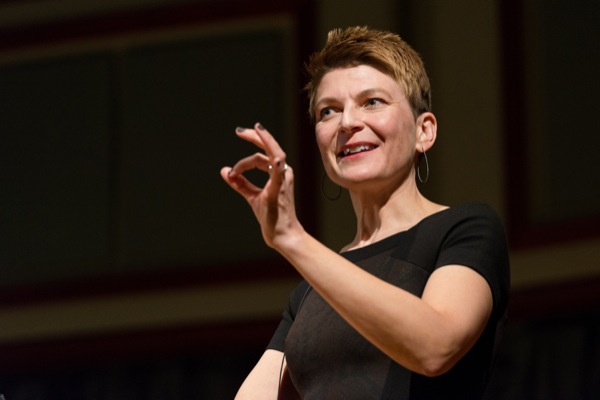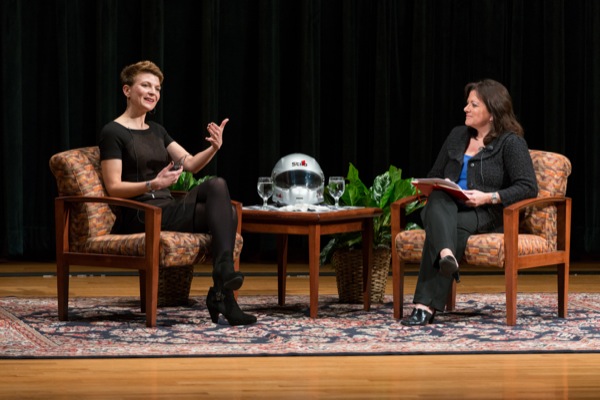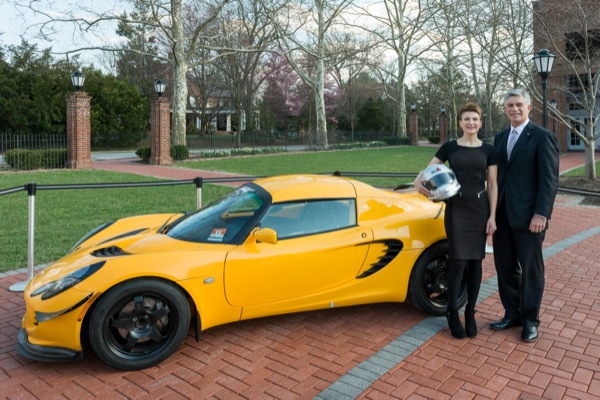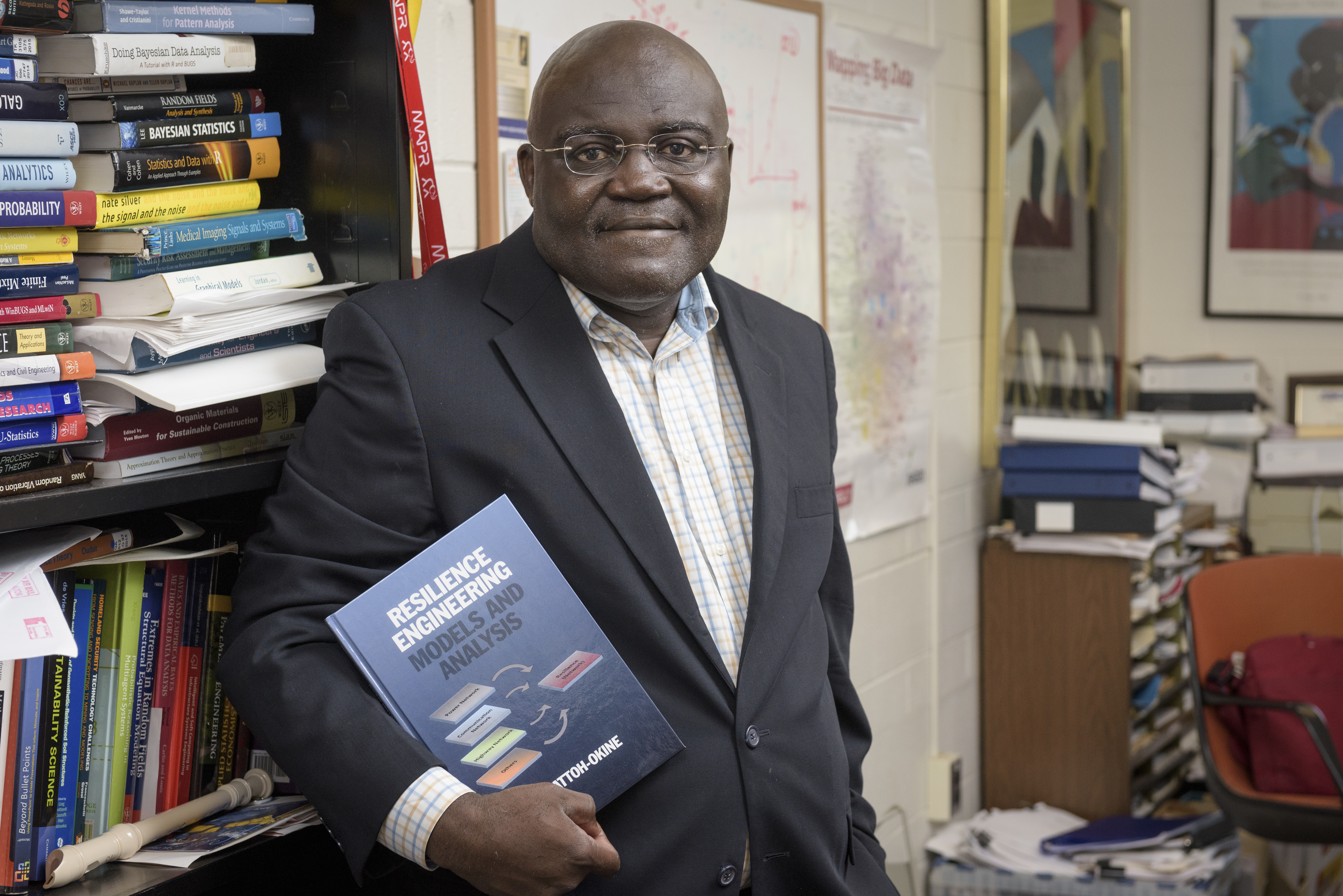'Fast Girl'
Lessons from an art historian turned race car driver
3:23 p.m., April 14, 2014--Ingrid Steffensen’s bright yellow Lotus Elise is a little fancier and a lot faster than the Volkswagen Beetle she drove when she first got behind the wheel of a car as a 16-year-old, but both cars are an integral part of Steffensen’s “auto biography.”
With the Lotus parked on the bricks outside the Roselle Center for the Arts, Steffensen chronicled her journey from college professor to “speed freak” as part of the President’s Leadership Series at the University of Delaware.
People Stories
'Resilience Engineering'
Reviresco June run
After earning a Ph.D. in art history at UD in 1994, Steffensen went on to teach at Princeton, Rutgers and Bryn Mawr.
But, as UD President Patrick Harker said in introducing her, “Something interesting happened to this highly trained academic, beloved by her students. She traded in the academy for the race track.”
Harker called Steffensen’s 2012 book, Fast Girl: Don’t Brake Until You See the Face of God and Other Good Advice from the Racetrack, “a story of reinvention and liberation that contains some of the best advice you’re ever going to get from a high-performance race car driver.”
Steffensen shared some of that story in her lecture, “This Is Your Brain at 135 Miles per Hour: Lessons in Learning from the Racetrack,” which was followed by a question and answer session moderated by Nancy Karibjanian, adjunct professor of communication and member of Delaware First Media’s board of directors.
Referring to the automobile as one of the most powerful transformative factors of the past century, Steffensen said, “We’re emotional about our cars — our grandmother’s car, the car we learned to drive in, the one we went to the prom in, the one we brought the baby home from the hospital in…. The succession of cars in our lives is as unique as a fingerprint.”
Steffensen’s life was organized around teaching and her family until the day her husband talked her into joining him at Watkins Glen racetrack in 2008.
“Before that, the biggest excitement in my life was doing The New York Times crossword and trying out the latest sushi restaurant,” she said. “I was terrified.”
Although she breathed a huge sigh of relief when her first try at navigating the frighteningly twisty course was over, she found herself reliving the “movie” of her Mini Cooper going around the track.
“I can’t express how it feels to your body,” she said. “I felt like I was going to go right off the edge, and I thought, ‘I’m going to die.’”
But on the drive from New York back to her home in New Jersey, she knew she wanted to do it again. She wanted to learn about this whole new world that was defined by “racing lines,” “slip angles,” “hitting the apex,” and “throttle steering.”
So, what was it that pulled this respected art historian away from the classroom and onto the racetrack?
“I realized that I had reached the point in my life where I was very competent at what I did,” she said. “By mid-life, you’ve crystallized what you know and what you do, so it was an absolute revelation to me to come to a place where I was learning and engaging my brain in a whole new way.”
Steffensen soon learned that being a novice in your mid-40s is humbling. “I saw myself as a good driver, and then I came to the race track and realized, ‘I don’t know a damn thing about this.’”
After awhile, though, she became skilled enough to become an instructor, and that’s when the real revelation hit her.
She was teaching a man in his 50s a tricky technique called “tail braking.”
“When he finally got it, he was like a kid on Christmas morning,” Steffensen said. “He was so excited I could practically see the sparks coming out of his helmet. He was high on his own brain. Dopamine is really good stuff.”
“That was when I saw that this could happen to us at any time in our lives,” she added. “Learning a new skill invigorates your life.”
During the Q&A after the talk, Steffensen said that the whole process of learning to drive a race car and teaching others to do it has made her more courageous and more likely to try other new things — from eating snails to skiing.
Steffensen hopes that she’s setting a good example for her 15-year-old daughter in terms of “pushing her boundaries,” but when it comes to teaching the teenager how to drive, that’s another story.
“We’re going to leave that to a professional,” she said.
Click here to view video of the entire April 9 President’s Leadership Series lecture featuring Ingrid Steffensen.
Race car connection
In addition to writing numerous articles and books on 19th and 20th century art and architecture, Steffensen has also written for a broader audience, including an article about UD’s GoBabyGo program that appeared in The New York Times “Automobiles” section on Sept. 6, 2013.
It’s not surprising that Steffensen was drawn to the story of how Cole Galloway, associate professor of physical therapy, is “giving mobility when legs can’t” by custom modifying battery-powered cars for young children who are unable to walk so that they can explore their environment with their peers.
“Any car enthusiast can relate to the great joys and limitless possibilities of the open road,” she wrote.
And she seems to be in full agreement with Galloway that “the drive for exploration through movement and mobility is a deep part of being fully human.”
About the President’s Leadership Series
The President’s Leadership Series brings prominent innovators and leaders in business, technology, athletics, the arts, and the humanities to campus to share their knowledge and life experience with the UD community.
About Ingrid Steffensen
Ingrid Steffensen holds a bachelor of arts degree from the University of Virginia, a master’s degree from Yale University, and a doctorate in art history from the University of Delaware.
Her work has been published in The New York Times, The Wine Enthusiast, New Jersey Monthly, and the Chronicle of Higher Education.
She is currently working on a new book, Life at Ankle Level, told from the viewpoint of her small dog.
Learn more about Steffensen at her website.
Article by Diane Kukich
Photos by Evan Krape













